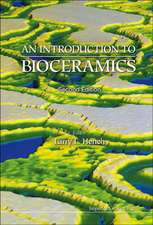Advances for Prosthetic Technology: From Historical Perspective to Current Status to Future Application
Autor Robert LeMoyneen Limba Engleză Hardback – 25 mar 2016
| Toate formatele și edițiile | Preț | Express |
|---|---|---|
| Paperback (1) | 649.90 lei 38-44 zile | |
| Springer – 25 apr 2018 | 649.90 lei 38-44 zile | |
| Hardback (1) | 716.09 lei 22-36 zile | |
| Springer – 25 mar 2016 | 716.09 lei 22-36 zile |
Preț: 716.09 lei
Preț vechi: 753.77 lei
-5% Nou
Puncte Express: 1074
Preț estimativ în valută:
137.02€ • 143.45$ • 113.38£
137.02€ • 143.45$ • 113.38£
Carte disponibilă
Livrare economică 17-31 martie
Preluare comenzi: 021 569.72.76
Specificații
ISBN-13: 9784431558149
ISBN-10: 4431558144
Pagini: 150
Ilustrații: XII, 135 p.
Dimensiuni: 155 x 235 x 12 mm
Greutate: 0.43 kg
Ediția:1st ed. 2016
Editura: Springer
Colecția Springer
Locul publicării:Tokyo, Japan
ISBN-10: 4431558144
Pagini: 150
Ilustrații: XII, 135 p.
Dimensiuni: 155 x 235 x 12 mm
Greutate: 0.43 kg
Ediția:1st ed. 2016
Editura: Springer
Colecția Springer
Locul publicării:Tokyo, Japan
Public țintă
ResearchCuprins
Amputations and prostheses, a topic of global concern.- Ankle-foot complex and the fundamental aspects of gait.- Prosthetic gait asymmetry and discomfort while walking with a transtibial prosthesis.- Testing and evaluation strategies for the powered prosthesis, a global perspective.- Passive transtibial prosthesis and associated prosthetic components.- Energy Storage and Return (ESAR) prosthesis.- Architecture of a powered prosthesis system: actuators, sensors, and control.- Transtibial powered prostheses: single and dual actuator configurations.- The MIT inspired powered prosthesis leading to the commercialized BiOM powered prosthesis, a precedence in transtibial prosthetic technology.- Future and advanced concepts for the powered prosthesis.
Recenzii
“The book aims to define the broad knowledge base required to inform research on transtibial prosthetic management. … a fair job of surveying a considerable body of knowledge and presenting it in an easily readable manner appropriate for engineers and biomechanists new to the transtibial prosthetic patient population. While the vast majority of prosthetic‐oriented books focus on their clinical aspects, the engineering and research focus of this one likely will appeal to those working in academic and product development settings.” (Christopher Robinson, Doody's Book Reviews, February, 2017)
Textul de pe ultima copertă
This book focuses on the advances in transtibial prosthetic technology and targets research in the evolution of the powered prosthesis such as the BiOM, which was derived from considerable research and development at the Massachusetts Institute of Technology. The concept of the book spans the historical evolution of prosthetic applications from passive to new and futuristic robotic prosthetic technologies. The author describes the reasons for amputation, surgical procedures, and an historical perspective of the prosthesis for the lower limb. He also addresses the phases and sub-phases of gait and compensatory mechanisms arising for a transtibial prosthesis and links the compensatory mechanisms to long-term morbidities. The general technologies for gait analysis central to prosthetic design and the inherent biomechanics foundations for analysis are also explored. The book reports on recent-past to current-term applications with passive elastic prostheses. The core of the book deals with futuristic robotic prostheses including their function and major subsystems, such as actuator technology, state machine control, and machine learning applications. Finally, the envisioned future trends in the prosthetic technology space are presented.
Caracteristici
Provides a global perspective on prosthetic technology and applications Enables readers to grow their skill set from those of a generalist to an applied skill set for prosthetic applications Covers the highly novel domain of the powered prosthesis and its unique utility Explains the evolution of prosthetic applications and envisioned future advances








